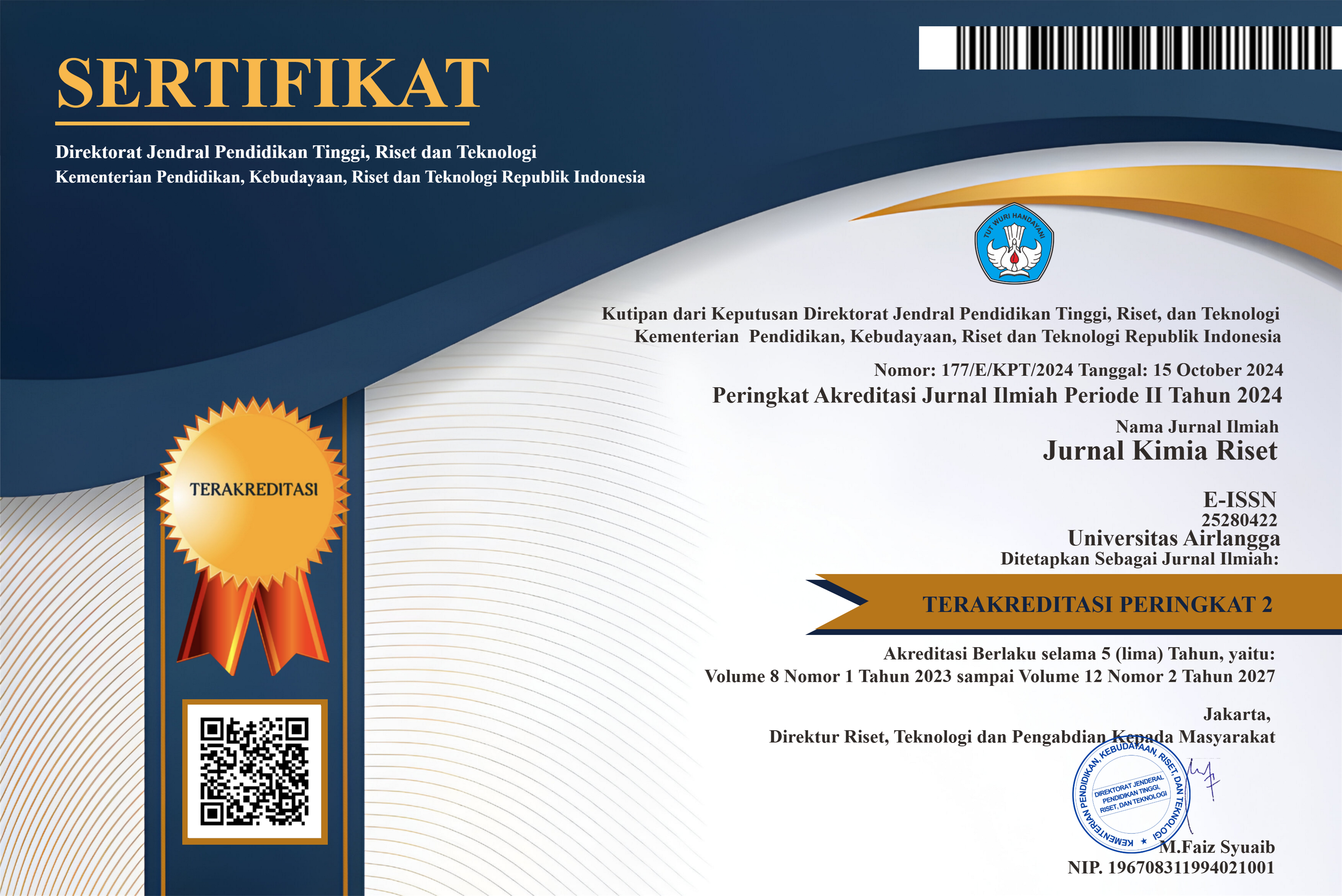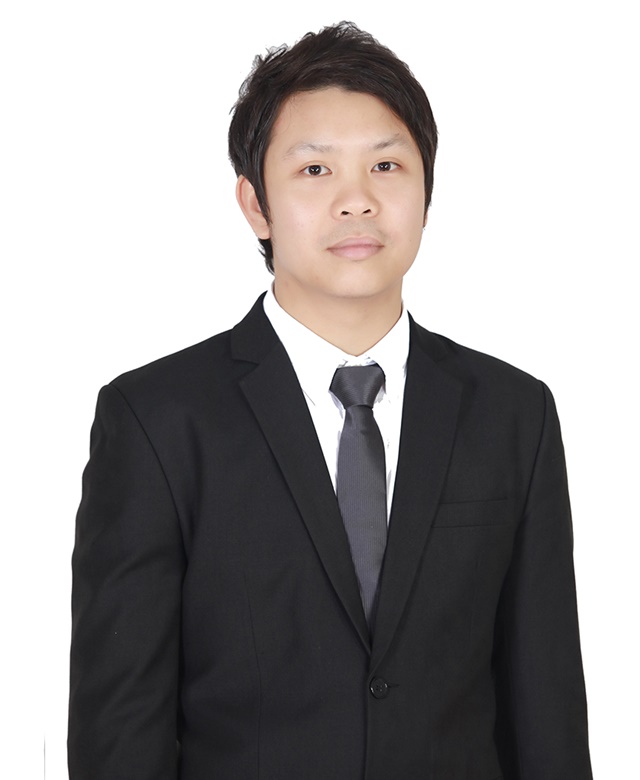CHARACTERISTICS OF STYROFOAM WASTE-BASED MEMBRANE THROUGH VAPOR AND LIQUID-INDUCED PHASE INVERSION PROCESS
Downloads
Polymeric membrane-based-Styrofoam waste in the form of a thin sheet was successfully prepared by a phase-inversion technique in different final solidification treatments, namely, immersion and evaporation. This study aims to identify the effects of different solidification processes on membrane properties such as hydrophobicity, pore configuration, porosity, and membrane temperature stability. Characterization was carried out using contact angle, SEM, FTIR, TGA, and porosity tests. The results showed that an increase in Styrofoam 18-30 wt.% in dimethylformamide (DMF) as solvent decreases the hydrophobicity by 9.5%. The average contact angle of 62–80° indicated that the obtained membrane was prepared by immersion treatment. The membrane subjected to evaporation treatment was hydrophobic. Moreover, the microscopy image shows that the immersed membrane was denser than the evaporated membrane. This showed that a higher exchange rate between the solvent and non-solvent (water) produced a tight membrane than free evaporation in air. The polystyrene membrane from Styrofoam exhibited excellent temperature stability up to 350 °C. In addition, the mechanical strength was affected by employing different solidification processes. The obtained results were also successfully tabulated from a statistical point of view to validate the conclusions. The following information can provide basic knowledge for modifying membrane-based-Styrofoam to optimize zero-waste goals.
Adamczak, M., KamiÅ„ska, G. and Bohdziewicz, J., 2019. Application of Waste Polymers as a Raw Material for Ultrafiltration Membrane Preparation. Proceedings MDPI. 2019 pp. 1–3.
Adamczak, M., KamiÅ„ska, G. and Bohdziewicz, J., 2020. Application of waste polymers as basic material for ultrafiltration membranes preparation. Water (Switzerland), 12(179), pp.1–15.
Baig, N., Alghunaimi, F.I. and Saleh, T.A., 2019. Hydrophobic and oleophilic carbon nanofiber impregnated styrofoam for oil and water separation: A green technology. Chemical Engineering Journal, 360, pp.1613–1622.
Bakeri, G., Ismail, A.F., Rahimnejad, M., Matsuura, T. and Rana, D., 2012. The effect of bore fluid type on the structure and performance of polyetherimide hollow fiber membrane in gas-liquid contacting processes. Separation and Purification Technology, 98, pp.262–269.
Deka, B.J., Lee, E.J., Guo, J., Kharraz, J. and An, A.K., 2019. Electrospun Nanofiber Membranes Incorporating PDMS-Aerogel Superhydrophobic Coating with Enhanced Flux and Improved Antiwettability in Membrane Distillation. Environmental Science and Technology, 53(9), pp.4948–4958.
Enger, B.C., Lí¸deng, R. and Holmen, A., 2009. Evaluation of reactor and catalyst performance in methane partial oxidation over modified nickel catalysts. Applied Catalysis A: General, 364(1–2), pp.15–26.
Fang, H., Gao, J.F., Wang, H.T. and Chen, C.S., 2012. Hydrophobic porous alumina hollow fiber for water desalination via membrane distillation process. Journal of Membrane Science, 403–404, pp.41–46.
Gomes, D.J.C., De Souza, N.C. and Silva, J.R., 2013. Using a monocular optical microscope to assemble a wetting contact angle analyser. Measurement: Journal of the International Measurement Confederation, 46(9), pp.3623–3627.
Henson, R.N., Cognition, M.R.C. and Unit, B.S., 2015. Reference , published by Elsevier , and the attached copy is provided by for non-commercial research and educational use including without limitation Author ' s personal copy Analysis of Variance ( ANOVA ), Elsevier Inc.
Huan, S., Liu, G., Han, G., Cheng, W., Fu, Z., Wu, Q. and Wang, Q., 2015. Effect of experimental parameters on morphological, mechanical and hydrophobic properties of electrospun polystyrene fibers. Materials, 8(5), pp.2718–2734.
Hubadillah, S.K., Othman, M.H.D., Matsuura, T., Rahman, M.A., Jaafar, J., Ismail, A.F. and Amin, S.Z.M., 2018. Green silica-based ceramic hollow fiber membrane for seawater desalination via direct contact membrane distillation. Separation and Purification Technology, 205, pp.22–31.
Iqbal, R.M., Nurherdiana, S.D., Hartanto, D., Othman, M.H.D. and Fansuri, H., 2018. Morphological control of La0.7Sr0.3Co0.2Fe0.8O3-δ and La0.7Sr0.3MnO3-δ catalytic membrane using PEG-H2O additive. IOP Conference Series: Materials Science and Engineering. 3 May 2018 Institute of Physics Publishing.
Jeon, Y.W. and Lee, D.H., 2015. Gas membranes for CO2/CH4 (biogas) separation: A review. Environmental Engineering Science, 32(2), pp.71–85.
Kesting, R.E., 1985. Phase Inversion Membranes. ACS Symposium Series. 1985 ACS, pp. 131–164.
Ketut Sumarni, N., Sosidi, H. and Rahman, A.R., 2013. Kajian Fisika Kimia Limbah Styrofoam dan Aplikasinya. Online Jurnal of Natural Science, 2(3), pp.123–131.
Khadijah, S. and Harun, Z., 2016. Preparation and characterization of low cost porous ceramic membrane support from kaolin using phase inversion / sintering technique for gas separation : Effect of kaolin content and non-solvent coagulant bath. Chemical Engineering Research and Design, 112, pp.24–35.
Lalia, B.S., Kochkodan, V., Hashaikeh, R. and Hilal, N., 2013. A review on membrane fabrication: Structure, properties and performance relationship. Desalination, 326, pp.77–95.
Nurherdiana, S.D., Etriana, R., Iqbal, R.M., Utomo, W.P. and Fansuri, H., 2019. Effect of The Sintering Process on the Morphology and Mechanical Properties of La0.6Sr0.4Co0.2Fe0.8O3-δ Asymmetric Flat Membranes Prepared by The Phase Inversion Method. Ceramics - Silikaty, 63(3), pp.305–314.
Nurherdiana, S.D., Gunawan, T., Widiastuti, N., Fansuri, H., Java, E., Analytics, D., Nopember, S. and Java, E., 2021. Grand Challenges of Perovskite and Metal Oxide-based Membrane : A Form of Dual-layer Hollow Fibre. Journal of Applied Membrane Science & Technology, 25(3), pp.17–28.
Rahmiati, M., Wafiroh, S. and Pudjiastuti, P., 2018. Pembuatan dan Karakterisasi Membran Fotokatalitik Hollow Fiber Selulosa Asetat-TiO2 untuk Degradasi Remazol Red 198. Jurnal Kimia Riset, 3(1), p.20.
Ramos-Olmos, R., Rogel-Hernández, E., Flores-López, L.Z., Lin, S.W. and Espinoza-Gómez, H., 2008. Synthesis and characterization of asymmetric ultrafiltration membrane made with recycled polystyrene foam and different additives. Journal of the Chilean Chemical Society, 53(4), pp.1705–1708.
Sitorus, B., Pranata, D. and Bara'allo Malino, M., 2022. Effect Of Sonication On The Properties Of Composite Polypyrrole/Microcellulose And Its Potential As A Capacitor. Jurnal Kimia Riset, 7(2), pp. 101-111.
Yap, E.P., Koay, S.C., Chan, M.Y., Choo, H.L., Ong, T.K. and Tshai, K.Y., 2021. Recycling Polymer Blend made from Post-used Styrofoam and Polyethylene for Fuse Deposition Modelling. Journal of Physics: Conference Series, 2120(1).
Zheng, Q., Wang, P. and Yang, Y., 2006. Rheological and thermodynamic variation in polysulfone solution by PEG introduction and its effect on kinetics of membrane formation via phase-inversion process. Journal of Membrane Science, 279, pp.230–237.
Copyright (c) 2023 Jurnal Kimia Riset

This work is licensed under a Creative Commons Attribution-NonCommercial-ShareAlike 4.0 International License.
COPYRIGHT NOTICE
1. By submitting the article to Jurnal Kimia Riset (JKR), the author has agreed to transfer some of the copyrights to the publisher of the research chemistry journal, Universitas Airlangga, indicated in the Copyright Transfer Agreement.
2. Authors still retain significant rights to use and share their own published articles for non-commercial purposes subject to Creative Commons Attribution-NonComercial 4.0 International License
3. All publications (printed/electronic) are open access for educational purposes, research, library, and other non-commercial purposes. Besides the purposes mentioned above, the editorial board is not responsible for copyright violations.















